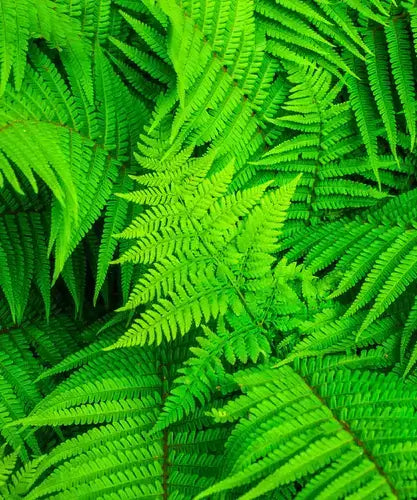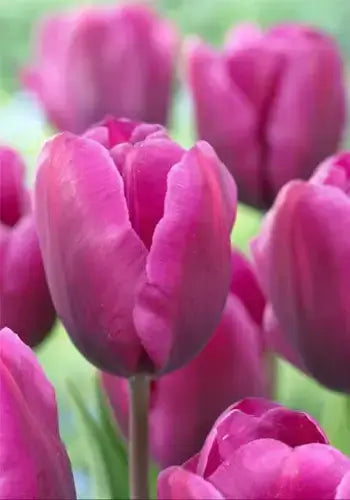Native Ferns and Their Benefits
Ferns are so widespread that there are more than twelve thousand fern species worldwide! Ferns can adapt to almost any climate, and they can thrive in cooler, temperate zones or warm and humid tropical regions.
In the eastern United States, native ferns often form a large part of the natural landscape, especially in shady woodlands. Their airy, delicate shapes with serrated leaves are instantly recognizable.
A lot of foragers love searching for fern fiddleheads, which are young ferns that haven't fully opened yet, that can be used to create various dishes. Some restaurants have fiddleheads on their spring menus as a seasonal delicacy. This brings a touch of spring to the table, making the dining experience a lot more special.
Most native ferns are deciduous and do not produce pollen or nectar, though sometimes the fronds are eaten by various wildlife. They also provide microhabitats for various insects and other creatures that live in woodland settings and provide shade and shelter for ground-feeding birds, turtles, and frogs. They will usually spread throughout a shady area over time. Ferns go dormant naturally and don’t need special pruning, though you may wish to remove the leaves once they turn brown in late autumn or parched weather.
Ferns Improve Soil Health
Although some ferns are delicious and nutritious, planting ferns is also a great way to boost the health of the soil in your garden. Adding ferns to your garden is not only a good design choice but one that will improve the health of your soil. Ferns help with soil stabilization because they will grow in conditions many plants won’t, such as heavy clay soils or acidic soils. Ferns form thick rhizomes and roots that can help prevent soil erosion, as they can grow on slopes and in between rocks.
Ferns Are Good for the Environment and Your Health
Native ferns also have the helpful ability to pull toxic materials from the soil, including heavy metals and arsenic. The process of removing pollutants from the soil is known as phytoremediation. They can also absorb airborne pollutants, including toluene, formaldehyde, and xylene, which can cause various adverse health issues, including headaches, breathing problems, and even cancer.
Native Ferns Species
Below are a few native ferns that will provide years of beauty and many environmental benefits for your garden:
The Ostrich fern, famous for its size, can reach heights of up to 6 feet, standing out as a giant among fern species. Its lush, bushy leaves resemble the feathery plumes of an ostrich, but the plant's size is most likely the true inspiration behind its name. Just like ostriches are much bigger than other birds, so is this fern compared to its siblings.The Ostrich fern does best in moist and fertile soil with organic matter (such as in thick forest underbrush with decaying plant matter). These ferns have large rhizomes and will spread quickly in a shady setting, so make sure to give them some room. They are essential for wildlife habitats and they are commonly seen growing throughout forests in the Northeast.
This is a more miniature deciduous fern that grows between 12-18 inches tall. The stems of the Maidenhair fern are relatively thin, and the fiddleheads are reddish. This fern does well in moist, rich, loam soil. It is popular amongst home gardeners for its smaller size, which allows for more design flexibility.
This deciduous fern usually grows between 2-3 feet tall, but in ideal conditions, may grow as tall as 5 feet. The Royal Fern likes rich, acidic soil that is relatively moist. It has large and well-separated leaves, giving them a sculptural appearance. This large fern does well alongside ponds, swamps, or other moist, boggy areas. Give it plenty of space, and it will spread beautifully.
Leatherwood Fern (Dryopteris marginalis)
This evergreen fern has dark green leaves and usually grows to about 2 feet tall. Its fronds are very distinctive, with delicate serrated leaves. The Leatherwood fern does best in moist, rich soil with good drainage. It’s very hardy and, unlike many other native ferns, does not spread quickly or invasively in the garden. This fern prefers places sheltered from strong winds.
Cinnamon Fern (Osmundastrum Cinnamomum)
Named for its spicy fragrance as it matures, this large fern also has edible fiddleheads. Growing up to 3 feet tall, the Cinnamon fern prefers a moist, boggy environment and is often seen growing alongside swampy ground in woodland areas and meadows on the outskirts of forests. The soft fronds are a nutritious food source for some wildlife, including wild turkeys and ruffed grouse.
Christmas Fern (Polystichum acrostichoides)
Growing 1 to 3 feet tall, these evergreen ferns have a thick, leathery appearance to their bright green leaves. Their growth habit makes them striking, as they have a full, upright fountain shape. The Christmas ferns are more adaptable to soil conditions than others and tolerate somewhat dry soil. They can also be grown as houseplants and will grow beautifully in a pot in a shady spot.
New York Fern (Thelypteris noveboracensis)
The New York fern is another fern that is adaptable to different soil conditions and will thrive in dry or moist soils. This attractive fern is on the shorter side, growing from 12-24 inches tall, and has delicate, tiny leaves that give it an airy look in the garden. The fronds are narrow at the base and tip and broader in the middle, giving them an unusual, curved shape.
This fern provides food for the caterpillars of two specific moths: the Pink-shaded Fern moth and the Close-banded Yellowhorn moth. Despite not producing flowers, this fern still provides food for what will eventually become pollinators!
Shop Our Fern Selection
Visit our online shop for a wide selection of plants and trees, or come say hi at our store location in Tennessee!We offer fast shipping nationwide so you can start transforming your garden today!
If you have any questions about ferns or if you have any other plant needs, don’t hesitate to contact us at customerservice@tennesseewholesalenursery.com, we’d love to hear from you!






